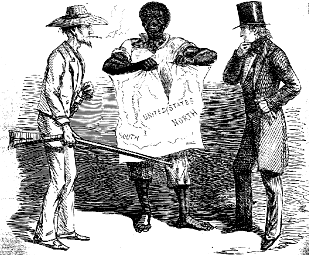

 ublished years before the outbreak of civil war in the United States, this cartoon demonstrates the English sensitivity to `the Negro Question' being debated at home and its repercussions for the American states. The image depicts the black slave at the center of the conflict between North and South, standing between the Southern farmer and the Yankee gentleman as he tears a map of America in a symbolic gesture that literally rips the nation's fabric in two. While English opinion was in many ways divided on the American conflict -- English abolitionists endorsed an anti-slavery agenda that was often at odds with scientific opinions of racial inferiority, and certainly the two stances were not exclusively in opposition - the general British population received the reports of strife abroad with a consciousness of the significance of race that had been nurtured by their own national experience in the colonies and in the realm of scientific theory.
James Hunt's work on "The Negro's Place in Nature,' which relegated blacks to a separate and inferior species of man, had been protested by British abolitionists, but also reflected the conclusions that many had drawn from racial conflicts in England's own colonies. The black slave pictured here displays the prognathous forehead and wide lips and nose that English, as well as American, craniologists and phrenologists had equated with barbaric, unrefined and underdeveloped peoples. His crazed smile, with its exaggerated animal-like aggression, displays the savage tendencies ascribed to blacks; it was indeed the fear of black revolt in America that pulled many Englishmen to the side of slavery. The prospect of a slave insurrection held resonance for the British, whose own class system depended on the stern relegation of the lower orders to their proper place, under the control of their superiors. It was a popular belief that black slaves were better off in their current position than they would be as freedmen; as property of their masters, they were guaranteed the home, livelihood and protection that suited the lazy, unintelligent nature of the laborer,
The diversity of Victorian attitudes towards the whites of the American North and South is also born out in this cartoon. Many British abolitionists were offended by the weak moral stance of the Northern states on the slavery question, while Southern plantation owners offended with both their slave practice and their secessionist tendencies; the ambivalence is shown here in the subtle caricatures of the Southern country bumpkin and the arrogant Yankee businessman, But certainly the crux of the matter is the "black business"; like Charles MacKay, many Englishmen believed "The `nigger' stops the way to peace, improvement, and occupation..."
ublished years before the outbreak of civil war in the United States, this cartoon demonstrates the English sensitivity to `the Negro Question' being debated at home and its repercussions for the American states. The image depicts the black slave at the center of the conflict between North and South, standing between the Southern farmer and the Yankee gentleman as he tears a map of America in a symbolic gesture that literally rips the nation's fabric in two. While English opinion was in many ways divided on the American conflict -- English abolitionists endorsed an anti-slavery agenda that was often at odds with scientific opinions of racial inferiority, and certainly the two stances were not exclusively in opposition - the general British population received the reports of strife abroad with a consciousness of the significance of race that had been nurtured by their own national experience in the colonies and in the realm of scientific theory.
James Hunt's work on "The Negro's Place in Nature,' which relegated blacks to a separate and inferior species of man, had been protested by British abolitionists, but also reflected the conclusions that many had drawn from racial conflicts in England's own colonies. The black slave pictured here displays the prognathous forehead and wide lips and nose that English, as well as American, craniologists and phrenologists had equated with barbaric, unrefined and underdeveloped peoples. His crazed smile, with its exaggerated animal-like aggression, displays the savage tendencies ascribed to blacks; it was indeed the fear of black revolt in America that pulled many Englishmen to the side of slavery. The prospect of a slave insurrection held resonance for the British, whose own class system depended on the stern relegation of the lower orders to their proper place, under the control of their superiors. It was a popular belief that black slaves were better off in their current position than they would be as freedmen; as property of their masters, they were guaranteed the home, livelihood and protection that suited the lazy, unintelligent nature of the laborer,
The diversity of Victorian attitudes towards the whites of the American North and South is also born out in this cartoon. Many British abolitionists were offended by the weak moral stance of the Northern states on the slavery question, while Southern plantation owners offended with both their slave practice and their secessionist tendencies; the ambivalence is shown here in the subtle caricatures of the Southern country bumpkin and the arrogant Yankee businessman, But certainly the crux of the matter is the "black business"; like Charles MacKay, many Englishmen believed "The `nigger' stops the way to peace, improvement, and occupation..."
Victorian initial "P" by Harlan Wallach ©copyright 1994.]